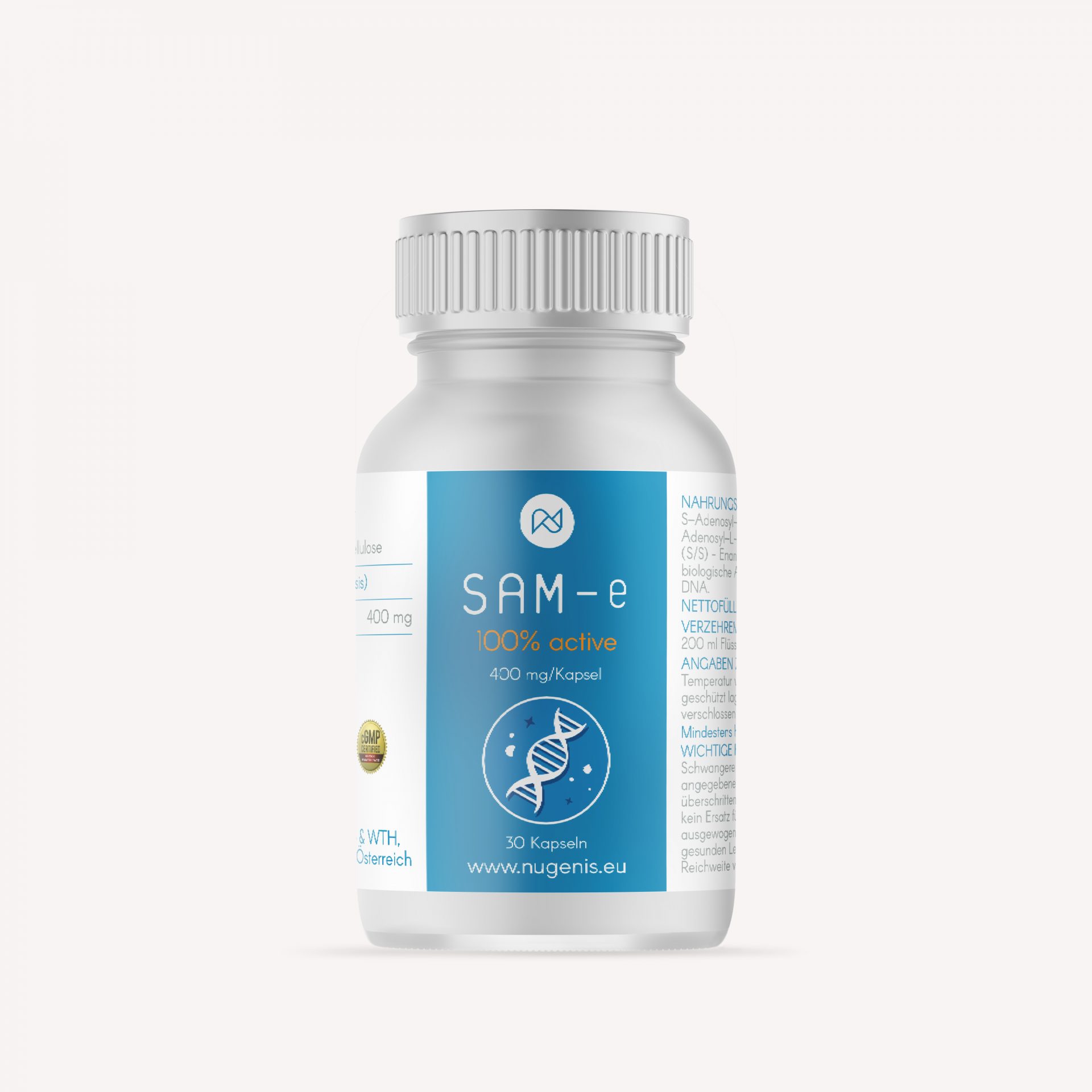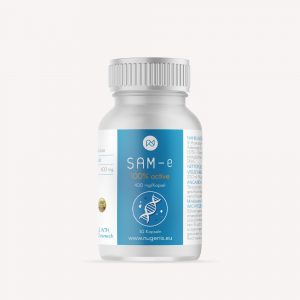
S-Adenosylmethionine (SAM-e): Epigenetics, Mood & Health
Introduction: A Small Molecule with Vast Influence
S-adenosylmethionine (SAM-e) is a small molecule with vast biological reach. As the universal methyl donor, it influences DNA, RNA, histones, neurotransmitters, and membranes. This positions SAM-e at the intersection of metabolism, epigenetics, and clinical medicine.
Biochemistry and Epigenetics
SAM-e is synthesized in the liver from methionine and ATP. It donates methyl groups for multiple processes:
– DNA methyltransferases (DNMTs): regulating gene silencing and activation.
– Histone methylation: shaping chromatin structure and transcription.
– Neurotransmitter metabolism: supporting serotonin, dopamine, and norepinephrine pathways.
After methyl transfer, SAM-e is converted to S-adenosylhomocysteine (SAH), which is then metabolized to homocysteine, requiring folate, vitamin B12, and B6 for recycling.
Mood and Antidepressant Effects
SAM-e plays a key role in the one-carbon cycle and methylation of neurotransmitters such as serotonin, dopamine, and norepinephrine. Clinical trials show that SAM-e supplementation exerts antidepressant effects comparable to SSRIs, but often with fewer side effects. Its mechanism involves direct methylation and stabilization of monoaminergic pathways.
Joint Protection and Analgesic Properties
SAM-e stimulates proteoglycan synthesis in cartilage, supporting joint structure and reducing inflammatory degradation. It alleviates osteoarthritis symptoms, acting similarly to NSAIDs, yet without gastrointestinal toxicity. Thus, SAM-e functions as both an analgesic and chondroprotective agent.
Anti-Dementia Potential
SAM-e downregulates excessive monoamine oxidase (MAO) expression, limiting hydrogen peroxide and ROS generated during neurotransmitter degradation. Excessive MAO activity, especially under chronic stress and cortisol exposure, is linked to neurodegeneration. By preventing this ROS-boost, SAM-e is a candidate for Alzheimer’s prevention and neuroprotection.
Hepatoprotection and Liver Function
The liver is the main site of SAM-e synthesis. SAM-e donates methyl groups for phosphatidylcholine synthesis, fuels glutathione production, and supports detoxification against xenobiotics, alcohol, and drugs. Clinical studies show SAM-e improves biomarkers in cholestasis, alcoholic liver disease, and NAFLD. Deficiency in hepatic SAM-e synthesis is linked to cirrhosis and progressive damage.
Nutrition and Support
SAM-e synthesis depends on adequate folate, vitamin B12, and vitamin B6. Dietary patterns such as the Mediterranean–Asian synergy—rich in soy (spermidine, high-quality protein, genistein), polyphenols, and plant compounds—support SAM-e levels and methylation capacity.
Info-Box — Daily Demand for SAM-e
- Turnover: The body makes and uses ~6 grams SAM-e per day.
- ATP link: SAM-e synthesis consumes cellular energy, tying methylation to mitochondrial health.
- Decline with age: Levels drop ~50% between age 20 and 70.
- Clinical use: Depression, osteoarthritis, liver disease.
Historical Background of SAM-e
The story of S-adenosylmethionine (SAM-e) begins in the early 1950s, when the Italian-American biochemist Giuliano Cantoni first isolated and described the compound. In 1952, Cantoni reported the enzymatic formation of a previously unknown sulfonium compound from methionine and adenosine triphosphate (ATP). He named it S-adenosylmethionine and demonstrated its fundamental role as a universal methyl donor in biological systems.Cantoni’s pioneering experiments showed that SAM-e was synthesized by the enzyme methionine adenosyltransferase (MAT), a discovery that immediately opened a new field in biochemistry. His work revealed that methyl groups could be transferred enzymatically to proteins, nucleic acids, and small molecules—a mechanism central to the regulation of cellular metabolism and gene expression.The publication of Cantoni’s findings marked the beginning of systematic research into one of the most versatile molecules in biology. From the start, SAM-e was recognized not only as a biochemical curiosity but as a central hub in methylation reactions, transsulfuration pathways, and polyamine biosynthesis. In retrospect, Cantoni’s 1952 paper anticipated the modern concept of “epigenetic control” long before the word epigenetics had entered mainstream biology.Today, Cantoni is regarded as the founding figure of SAM-e research, and his work remains a cornerstone reference for both biochemical and clinical studies.
Current Research
Research on SAM-e has remained highly active over the past decades. While its role as the universal methyl donor is well established, current studies focus on unraveling the detailed mechanisms by which SAM-e modulates epigenetic regulation, neurotransmitter metabolism, and mitochondrial function. Particular attention is being given to SAM-e’s potential in the treatment of neurological and psychiatric disorders such as depression, bipolar disorder, and Alzheimer’s disease. By modulating monoamine metabolism and influencing DNA and histone methylation, SAM-e represents a promising adjunct to conventional antidepressant and neuroprotective therapies. .Recent advances also link SAM-e to the regulation of redox balance and ROS detoxification placing it at the crossroads of oxidative stress and epigenetic resilience.
Quality and Isomer Purity
Pharmaceutical-grade SAM-e requires strict control of isomer composition. The biologically active form is the S,S-isomer, whereas the R,S-isomer is inactive and can interfere with bioavailability. High-quality formulations contain more than 95% S,S-isomer, ensuring reliable efficacy. Poorly manufactured preparations with high R,S-content lose biological activity quickly and may explain inconsistencies in early clinical trials. Another critical factor is the weigh-in (salt vs. ion content). Commercial SAM-e is typically supplied as a tosylate disulfate salt, and the effective content of the active SAM-e ion can differ by 20–30% between formulations. This makes quality labeling essential, particularly for therapeutic use.
Clinical Applications and Liver Protection
SAM-e plays a central role in hepatic metabolism, as the liver is the primary site of SAM-e synthesis. It is indispensable for the methylation of phosphatidylcholine and other lipids, ensuring membrane stability and bile flow. Clinical trials have demonstrated that SAM-e supplementation improves liver function tests in patients with cholestasis, hepatitis, and cirrhosis, highlighting its hepatoprotective effects.
Beyond hepatology, SAM-e shows clinical promise in:
- Depression: Effective as an adjunct to SSRIs, with a faster onset of antidepressant action.
- Osteoarthritis: Comparable analgesic efficacy to NSAIDs, but with fewer gastrointestinal side effects, partly through chondrocyte protection.
- Neurodegeneration: Prevents excess MAO expression, thereby reducing ROS-driven neuronal damage and contributing to antidementia effects.
Closing Reflection
SAM-e is life’s signature ink. With every methyl group, it edits the genome, lifts mood, eases pain, protects cartilage and liver, and scripts resilience against age and disease.
Eduard Rappold
Note: This information is provided for educational purposes only and does not replace professional medical advice. Always consult qualified healthcare professionals for medical concerns.
Copyright © Eduard Rappold 2025
http://nugenis.eu/shop
NUGENIS specializes in epigenetically active nutritional supplements.

